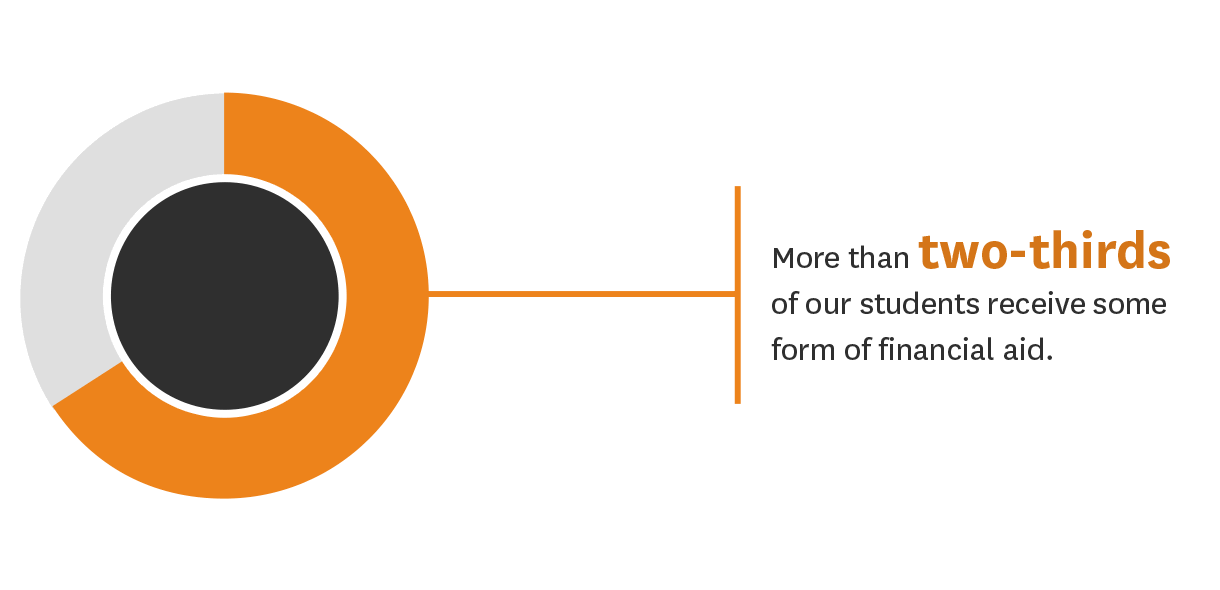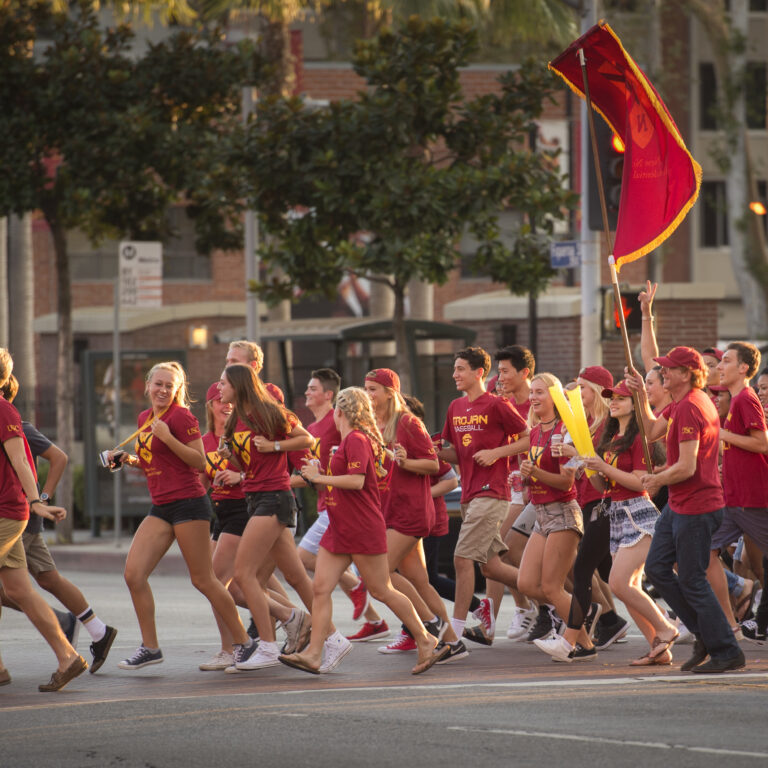Counselor’s Guide to Financial Aid
Financial Aid & Scholarships
Undergraduate financial aid can come from a variety of federal, state, university, and private sources and may include gift aid or student employment—funds that do not have to be repaid—or student or parent loans—funds that can be borrowed to cover educational expenses and need to be repaid after graduation.
Talking About USC Financial Aid
-
Cost is a key consideration for students in deciding which college to attend. And while current headlines tend to focus on cost, a college education is also an investment in a student’s future. Its value increases over time.
College graduates earn more over their lifetimes and enjoy greater access to health care than high school graduates.
At USC, students graduate uniquely prepared for the challenges of the 21st century. They effectively engage with other cultures, examine issues through a global perspective, and draw from a multidisciplinary education that encourages them to make connections and synthesize information. They also give back to their communities through real-world problem-solving—as researchers, interns, volunteers and mentors.
Investing in education, especially a USC education, not only benefits the student. It benefits everyone.
At USC, we are proud of the resources we have to offer our students. We maintain a strong commitment to funding student financial aid and administer one of the largest programs in the country.
- We work with families to meet 100 percent of their demonstrated financial need.
- Funding for student aid has increased at a higher rate than tuition costs every year for the last few years.
- Nearly two-thirds of USC undergraduates receive some form of financial aid.
- USC awarded more than $902 million from all sources to undergraduates in the last academic year. The majority of that comprised gift aid—financial aid that does not need to be paid back.
The total gift aid to undergraduates from all sources (university, federal, state, other) for the 2023-2024 academic year was more than $732 million (nearly 80 percent of all aid awarded).
- Our admission process is need-blind. Ability to pay does not affect our admission decisions.
The Financial Aid Application process at USC
This section will help clarify and explain the financial aid application process for new students and their parents.USC requires both the Free Application for Federal Student Aid (FAFSA) and the CSS Profile.
- Students’ eligibility for USC need-based aid is calculated using the Institutional Methodology, based on information provided in the CSS Profile.
California students who meet the eligibility requirements should complete the CADAA (instead of the FAFSA) if they are undocumented, have Temporary Protected Status (TPS), or if they hold a U visa.
Application Deadlines
The FAFSA, CADAA, and CSS Profile become available in October of each year. Please visit our Dates & Deadlines page for specific dates and instructions.Tax information
- We request actual tax returns or supporting documentation only if necessary for verification.
- Most supporting documentation can be submitted via our website.
Notification
- Once we receive a student’s application, we will notify the student by email if any other information is required.
- Students can also check their financial aid status online by logging in to their Financial Aid Summary and Tasks (FAST) portal.
- Students should submit any additional information that we requested as soon as possible to prevent any delays in receiving their financial aid summary. Materials should be submitted online.
-
We know that families are concerned about student indebtedness and the national dialogue about this issue has intensified. At USC:
- About thirty-one (31) percent of all undergraduates borrow from federal student loan programs, not including parent, and/or private loans.
- Approximately eight (8) percent borrow from the Federal Direct Parent PLUS program.
- Approximately three (3) percent borrow private loans.
Graduates from the class of 2022 who entered USC as first-time students borrowed a cumulative average of $19,413 in federal student loans.
The College Board estimates that about 54 percent of all college seniors who graduated in 2021 had student loan debt, with an average of $29,100 per borrower. The national average includes public and private non profit institutions.
Our Commitment to Affordability
USC administers one of the largest financial aid programs in the United States and works with families to bridge the gap between the cost of attendance and what families can afford to pay out of pocket.
Please note: Students are considered for full financial aid only if they meet all deadlines and eligibility requirements.
How much financial aid does USC award to undergraduates?
$549.2 Million
Financial aid from all university sources exceeds $549 million.
$902
Million
Amount of financial aid disbursed from all sources for 2023-24 (including work-study and loans).
What percentage of USC’s undergraduates receive financial aid?

More than two-thirds of USC undergraduates receive some sort of financial aid, including need-based grants, merit scholarships, Federal Work-Study and loans. Among the 2024 entering first-year class, approximately 19 percent received a USC Merit Scholarship.
USC enrolls more low-income students (as defined by Pell Grant eligibility) than most private research universities.
In fall 2023, 22 percent of enrolled undergraduates received Pell Grants.
Most importantly, low-income and under-represented minority students at USC graduate at rates comparable to the overall undergraduate population.
USC’s admission process is need-blind. Ability to pay, or a student’s interest in financial aid, does not affect admission decisions.
Saving for College
A college education represents a significant investment in a child’s future. While college costs have risen each year, the resources below can help families plan well in advance and save money over the long term. Many of these plans are tax free and/or do not charge extra fees.
Regardless of their eligibility for financial aid, most families will still need funds to pay for any expenses not covered by financial aid, and for any other personal expenses the student may incur. Savings plans are a good way to plan for and cover these expenses, especially as savings and investments held in parents’ names have a smaller impact than student assets on calculations of the Student Aid Index.
-
Owned and operated by 285 private colleges and universities across the country, the Private College 529 Plan allows families to pre-purchase college tuition at today’s prices. The plan protects families from tuition increases (roughly 3-8 percent a year), guaranteed and tax free.
How Does It Work?
- When the account is opened, the account owner names the beneficiary.
- Account owners do not have to select a school until the beneficiary is accepted and enrolls. However, during the investment period, account owners may select up to five “sample schools” to find out how much the plan would be worth at each one.
- When the beneficiary enrolls at a participating college, the 529 certificate is redeemed and the school receives the market value of the investment.
- The value of the prepaid tuition is guaranteed by participating schools, regardless of what happens in the financial markets. What you pay today will be honored tomorrow.
- If the student attends a school outside the Private College 529 Plan network, the account owner can name another beneficiary, rolls the assets into another 529 plan or request a refund.
- Private College 529 assets may be used to pay only for undergraduate tuition and mandatory fees.
Most 529 savings plans are sponsored by individual states and are not guaranteed to keep pace with tuition increases. The Private College 529 Plan is NOT sponsored by a state. Run by its participating schools, it is designed to help keep tuition affordable.
To learn more, please visit PrivateCollege529.com or call 1-888-718-7878.
-
Administered by various states, prepaid tuition plans allow parents to pre-purchase college tuition based on today’s rates. Funds are paid out at the future cost when the student enrolls in college.
Unlike the Private College 529 Plan, account earnings for these plans are based upon the market performance of the investment. These plans are currently available in 13 states. To learn more, please visit collegesavings.org.
-
Offered by the federal government, U.S. Treasury securities comprise a variety of notes and bonds that allow you to invest and save your money over a fixed amount of time, with minimal risk. Visit savingsbonds.gov for more information.
Tools and Resources
Many students and families are surprised to learn that a USC education may be more affordable than they think. Our Financial Aid Calculators allow prospective students and their families to estimate their own cost of attendance and potential eligibility for certain types of financial aid.
Students and families should note, however, that estimates are based on prior-year figures for tuition, fees, books, and housing costs. Also, Financial Aid Calculators cannot substitute for a full review of a family’s finances. Amounts given are estimates only and not a guarantee of financial aid.
NPC = Cost of Attendance (price) – grant and scholarship aid
How Financial Aid Works
This video introduces viewers to the basics of qualifying, applying for, and receiving financial aid.
The Investing in Your Future provides in-depth information about the financial aid process for prospective students and their parents.
Investing in Your Future: Spanish
This website compares individual colleges based on access, affordability and outcomes.
This tool offered by the College Board may help estimate a family’s expected out-of-pocket costs. Be sure to use the Institutional Methodology.
Bigfuture by the College Board
The College Board’s college and scholarship search tool.
Contact Us
Our dedicated team of professionals is available to help with any questions or concerns.
Phone
(213) 740-4444
Monday – Friday, 9:00 a.m. – 5:00 p.m. Pacific Time
E-mail
Email us using our form.
In Person
John Hubbard Hall (JHH) Lobby
Monday – Friday, 9:00 a.m. – 5:00 p.m.
Mailing Address
USC Financial Aid Office
University of Southern California
700 Childs Way
Los Angeles, CA 90089-0914
We also have a dedicated outreach team who attend admission events, high school and community nights and helps with special populations. We look forward to working with you and your students in the coming year!
